
Squirrels, Chipmunks and Marmots
Squirrels, chipmunks and marmots are found throughout Oregon.

Types of Squirrels, Chipmunks and Marmots
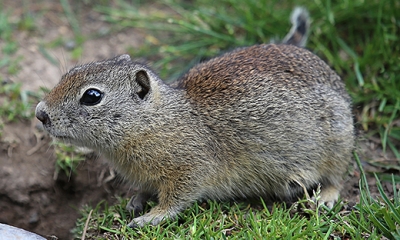
Belding's ground squirrel is a medium-sized ground squirrel without spots, stripes, or splotches. The pelage is smoky gray with some pinkish on the face, feet, and venter, and with a more or less well-defined reddish or brownish band in the middorsal region. The tail is cinnamon on the ventral surface.
This squirrel occurs south and east of a line connecting Enterprise, Heppner, Maupin, Wasco Sisters, Diamond Lake, and south to Fish Lake. It may occur in steppe and shrub-steppe area, particularly in meadows; sagebrush flats; and small-grain pasture , and hay-crop fields, and sometimes in openings in woodlands.
The Belding's ground squirrel spends six to eight months in topor; duration and dates of emergence vary with elevation. In preparation, these squirrels become obese as they must rely on body fats for energy during dormancy.
Photo by ©Keith Kohl, ODFW
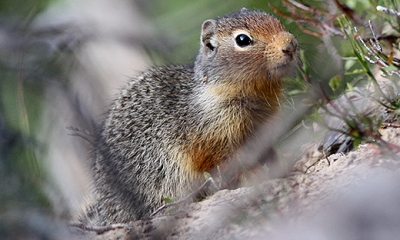
Columbian ground squirrels occur in the Wallowa and Blue Mountains in small openings and meadows in forested areas. Most of these areas flood each spring so the ground squirrels are restricted to the edges of meadows or to mounds within them.
Columbian ground squirrels spend an average of 245-255 days in torpor and an average of only 69-94 days active. While above ground, they spend more time alert than in any other activity. This ground squirrel engages in a greeting behavior that resembles kissing, touching mouth and nasal areas usually for one to five seconds before other social behavior.
Photo by ©Keith Kohl, ODFW
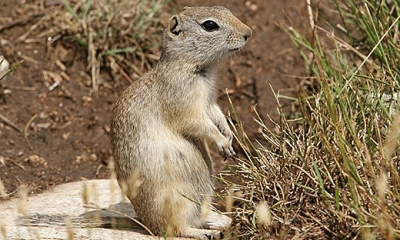
The Wyoming ground squirrel is a medium-sized ground squirrel without spots, stripes, or splotches. The dorsal pelage is grayish with a slight buffy wash. In the field, it appears distinctly more yellowish than other ground squirrels that it might be confused with. The tail is usually longer, as well.
This ground squirrel is found in southeastern Oregon and emerges from hibernacula in the spring and by late July has again entered torpor. During the active season, individuals usually become active within an hour after sunrise.
Photo by Andrew Hoffman, Flickr
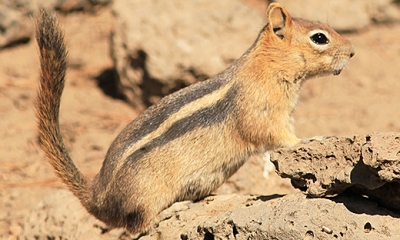
The golden-mantled ground squirrel doubtlessly is the most distinctively marked ground squirrel in Oregon; a white stripe bordered on both sides by a black stripe extends from the shoulder to the hip. From nose to nape above the eye, the head is russet. The back between the stripes is grizzled dark grayish-brown becoming less grizzled on the rump; lateral to the stripes the color grades to a light buffy-gold on the venter. The face, shoulders, front legs, and feet are a bright orangish-gold.
This ground squirrel occupies the east slope of the Cascade Range and most of central Oregon, and the Siskiyou mountain, Wallowa Mountains, Steens Mountain and southeastward south of Huntington, Baker County.
The golden-mantled ground squirrel is active diurnally from late winter-early spring to mid autumn. Most of its activity is confined to the ground where it travels rapidly among stumps, logs, or other slightly elevated prominences. In late summer it is highly visible as it scurries about gleaning seeds.
Photo by Simon Wray, ODFW

Merriam's ground squirrel is one of the two small gray ground squirrels in Oregon without stripes or spots.
Most of the geographic range of this squirrel is in Oregon, where it occurs south and east of a line connecting Huntington, North Powder, Maupin, Warm Springs, Bend, and Fort Rock, Summer Lake, and Plush. This species does not occur south of the North Fork Owyhee River in Malheur County.
These ground squirrels emerge in early March, breed, rear their young, become exceedingly fat and go into their hibernacula by early August.
Photo by ©John Rakestraw
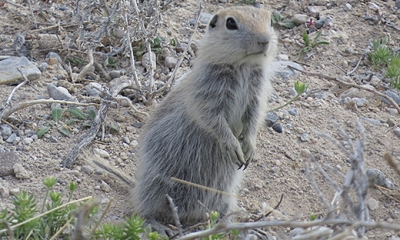
The Piute ground squirrel is the other of the two small gray ground squirrels without stripes or spots.
In Oregon, it occurs south of Sheepshead and Cedar mountains in Malheur County. It is a species of the High Desert and commonly occurs in habitats in which the dominant shrub is big sagebrush, saltbush, or greasewood. It is commonly associated with rocky outcrops, levees, railroad embankments, ditchbanks, and sand dunes. Some occur in fencerows and edges of alfalfa and small-grain fields.
These ground squirrels are usually active for three to five months each year. They emerge from their hibernacula in February or early March. Although the species is diurnal, most activity is restricted to the cooler morning hours when winds are calm. Much of the active period is devoted to feeding. It climbs into shrubs to feed on the leaves or to obtain a better view of the surrounding area. It can also swim well.
Photo by Bryant Olsen, Flickr

The Washington ground squirrel is the smaller of the two short-tailed, spotted ground squirrels in Oregon. The dorsum has squarish grayish-white spots on a background of pale smoky-gray with a pinkish wash to brownish gray.
This squirrel is endemic to the Deschutes-Columbia Plateau Province east and south of the Columbia River and east of the John Day River.
A colonial species, it emerges from dormancy in January to early March, males before females. At the approach of a potential threat, the Washington ground squirrel produces a soft, lisping whistle. Other members of the colony respond by standing upright, repeating the whistle, and quickly retiring to their burrows.
The Washington ground squirrel is an Oregon Conservation Strategy Species in the Columbia Plateau ecoregion.
Photo by ©Keith Kohl, ODFW

The Eastern gray squirrel is the smallest member of the genus in Oregon. This squirrel was introduced into Oregon and can now be found in Salem, Portland, Milwaukie, and Vale. All populations in Oregon have been found in urban areas.
This squirrel is active throughout the year, activity restricted to daylight hours.
Photo from Washington Fish and Wildlife
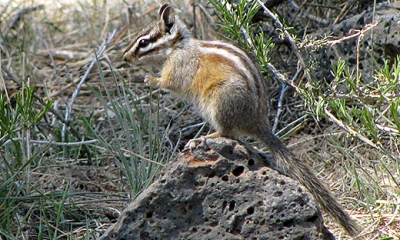
The yellow-pine chipmunk is one of the smallest in Oregon, only slightly larger than the least chipmunk. Its face is marked with a dark stripe, followed laterally by two alternate light and dark stripes. The outermost light strip is nearly white.
It occurs on the east slope of the Western Cascades and eastward through most of the remainder of Oregon, except it is absent from most of the Columbia Basin and much of southern Harney, eastern Malheur, and southern Baker counties. Its range also extends westward in the Siskiyou Mountains in southern Jackson and Josephine counties. Ponderosa pine seems to be the common factor in habitats occupied by this species.
Yellow-pine chipmunks are active during the daylight hours, with activity commonly commencing slightly before sunrise, then, following a midday break during hot days, continuing until slightly after sunset.
Photo by Simon Wray, ODFW

The Western gray squirrel is the largest tree squirrel in the state. It occurs from central Wasco, Jefferson, Deschutes, and Klamath counties west, except for unforested portions of the Willamette Valley, to central Washington, Benton, Lane, Douglas, Coos, and Curry counties. It is commonly associated with mixed forest communities.
These squirrels are wary and secretive, but curious; they examine new objects placed in their environment but, once captured, they often avoid live traps.
Western gray squirrels are an Oregon Conservation Strategy Species in the Willamette Valley ecoregion.
Photo from ODFW

The least chipmunk is the smallest chipmunk in Oregon, but it is only slightly smaller than the yellow-pine chipmunk. As in all chipmunks, the face is marked with a dark stripe through the eye bordered on each side with a light- and a dark-colored stripe. The middorsum is marked with a dark-colored stripe followed on each side by two alternating light- and dark-colored stripes.
The least chipmunk has the largest geographic range of any chipmunk. In Oregon, it occurs east of the Cascade Range except in the Columbia Basin and most of the Blue Mountains. In general, it is a chipmunk of the shrub-steppe, but sometimes it occurs at the edges of open forests.
Least chipmunks are active during the daylight hours. It moves swiftly through its habitat, disappearing when pursued too closely, but reappearing a little further away if the observer remains motionless for a few moments. They can often be seen sitting in the tops of shrubs.
Photo by ©Keith Kohl, ODFW
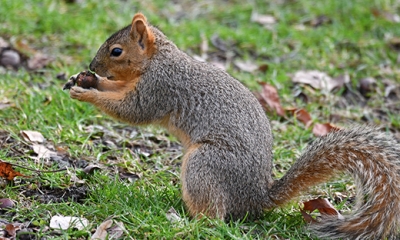
The Eastern fox squirrel is among the larger of the tree squirrels in Oregon. Its body is the typical squirrel shape. The ears are short, rounded, and without tufts. The tail is flattened and somewhat fluffy.
In Oregon, it has been found in Multnomah, Washington, Marion, Lane, Union, Clackamas, Yamhill and Baker counties, all occurring in urban areas or in association with nut orchards.
The Eastern fox squirrel is active throughout the year during daylight with its greatest activity in the early morning and late afternoon. During autumn, they are exceptionally active on the ground, scatter-hoarding nuts and acorns as they mature and ripen.
Photo by Brian Henderson, Flickr
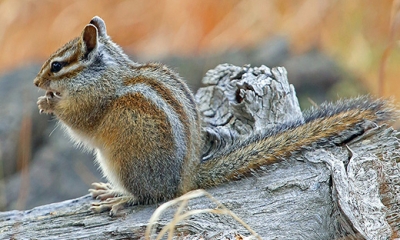
The pelage of this chipmunk is marked with five dark and four light stripes on the dorsum; the middorsal stripe is usually black and nearly always darker than the other four dark stripes. The sides of the face are marked with three brown and two light gray stripes, a patch behind the ear is light gray. The tail is blackish frosted with ochre dorsally and rusty brown ventrally. Allen's chipmunk produces a call of a rapid series of three or four to as many as 10 syllables.
In Oregon, it occurs in forested areas along the eastern part of the Cascade Range from Ollalie Forest Camp and Warm Springs in Jefferson County south to eastern Ashland, Jackson County, and Lakeview, Lake County. These chipmunks are forest dwellers that, in addition to climbing in trees, frequent dense thickets and rocky outcrops. Allen's chipmunks are superb climbers.
Photo by ©Keith Kohl, ODFW
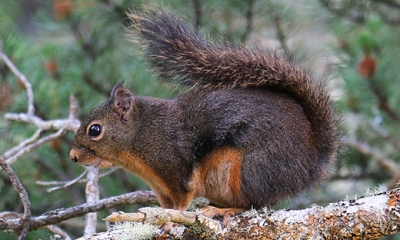
The Douglas' squirrel is one of the smaller tree squirrels in Oregon. The color and markings of this squirrel differ individually, geographically and seasonally, appearing a dusky olive to brownish gray with an indistinct band of reddish brown with a blackish band along the flanks.
In Oregon, it occurs in coniferous forests from the Pacific coast to as far east as western Baker County.
Douglas' squirrels are active during the daylight hours year-round, although they may remain in their nests or tree dens for a day or two during inclement weather.
Photo by Kathy Munsel, ODFW
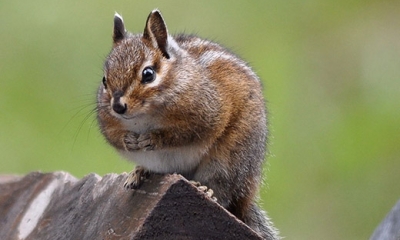
The Siskiyou chipmunk is slightly smaller than the Townsend's chipmunk and slightly larger than the Allen's chipmunk. The pelage is marked with five dark and four light stripes on the dorsum; the middorsal stripe is usually black and nearly always darker than the other four dark stripes. The sides of the face are marked with three brown and two light gray stripes; a patch behind the ear is light gray.
It occurs in Curry, Josephine and Jackson counties south of the Rogue River; in extreme western Klamath County; in extreme eastern Douglas and Lane counties; and in extreme southeastern Linn County.
Siskiyou chipmunks exhibit three diurnal peaks of activity: an early morning peak, a midday peak, and the maximum peak in early evening.
Photo by Frank Lospalluto, Flickr
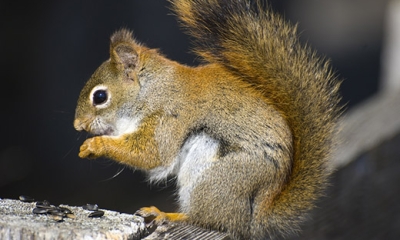
The red squirrel is also a small tree squirrel, only slightly larger than the Douglas' squirrel. They occur in the montane forested portions of Wallowa, Union, Umatilla, Morrow, Malheur and Baker counties. It is a largely arboreal, forest-dwelling species and although often occupying areas vegetated by other conifers, it is associated most frequently with lodgepole pine.
Activity patterns of red squirrels are similar to those of Douglas' squirrels. Much activity is directed toward foraging, gathering and catching cones, feeding, and resting.
Photo by Shawn Nystrand, Flickr
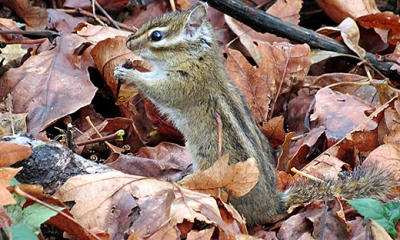
Townsend's chipmunk is the largest member of the genus in Oregon.The pelage of this chipmunk is dark and dull but as in other Oregon chipmunks, there is a dark brown to blackish middorsal stripe with alternate light and dark stripes, laterally, a total of five dark and four light stripes. Alternate dark (three) and light (two) stripes adorn the sides of the face. The throat, belly, and a patch behind the ear are white. The tail is black on the tip and the margins are frosted above with buff or white-tipped hairs.
Townsend's chipmunks have been found on the west slope of the Cascade Range in Clackamas, Linn, and Lane counties in old-growth forests and clear-cuttings. They tend to be more secretive than most and are heard more often than seen. When active, they tend to stay in the shadows or hidden by thick vegetation. When observed, they commonly are sitting on a stump, log, or low branch.
Photo by Stephanie Savenkoff
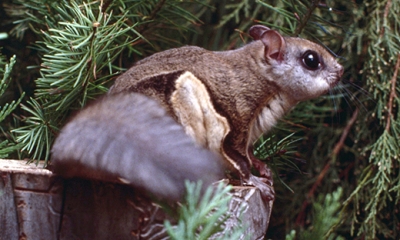
The Northern flying squirrel is the smallest arboreal squirrel in Oregon. It is typically squirrel-like except that the fore- and hind legs are connected by a furred patagium that extends from the ankle to the wrist. It is lead colored with buffy brown to brown tips.
It occurs in forested areas west of the Cascade Range and eastward to near Lakeview, Lake County and Paulina Lake, Deschutes County. The species also occurs in the Blue, Ochoco, and Wallowa mountains.
Northern flying squirrels are mostly nocturnal although individuals may be observed abroad during light hours on rare occasions. They are usually active for two hours immediately after sunset, then after a sojourn in the nest are active for about one and a quarter hours in the few hours before sunrise. Activity continues throughout the year, even at low temperatures and in snow.
Photo by Jim Collins, ODFW
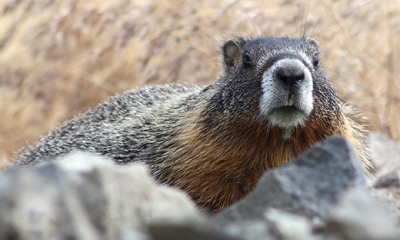
The yellow-bellied marmot is the largest squirrel in Oregon. It has short legs, a short and bushy tail, and ears short and covered with fur. The pelage consists of a dense, wooly underfur covered by long, course guard hairs and is distinctively colored and marked.
In Oregon, it occurs in suitable habitats east of a line connecting Mt. Hood, Hood River County, and Mt. Mazama, Klamath County, except for the Columbia Basin. The primary requisites of suitable habitats for the yellow-bellied marmot are boulders or piles of rocks and an abundance of succulent vegetation in close proximity thereto. Occasionally, an abandoned building or pile of logs serves as a substitute for rocks.
Marmots hibernate; body temperature, heart rate, respiration, and physiological processes decline to extremely low levels. In central Oregon, marmots emerged from hibernation the last week of February or the first week of March, adult males first, followed in order by adult females, yearling females, and yearling males. Adults remained active for 135-150 days, entering hibernation by the end of July, or for juveniles mid August.
Photo by Kathy Munsel, ODFW
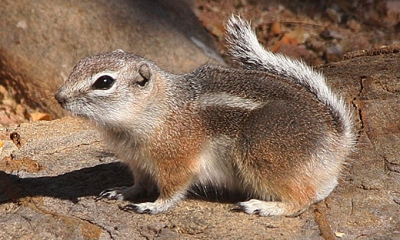
The white-tailed antelope squirrel is the smallest species of ground squirrel in Oregon. Although rather cryptically colored, it is marked distinctively: the grayish-brown dorsum and sides are separated by a white stripe on each side. The stripes are tapered at both ends and extend from behind the ear to near the base of the tail. A white line encircles each eye, the underside of the tail is white grading to grayish near the tip and the venter is white.
In Oregon, it occurs south and east of a line connecting Vale, Malheur County; Harney Lake, Harney County and Paisley, Lake County.
The white-tailed antelope squirrel is active at all seasons. It does not hibernate. When active above ground, these squirrels move from one shady spot to the next extremely rapidly with the tail held over the back as a sunshade.
Photo by J. N. Stuart. Flickr
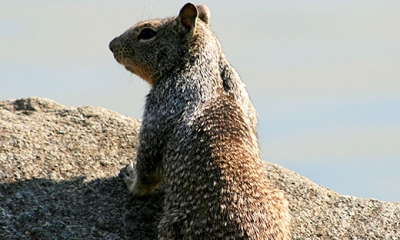
The California ground squirrel is a large, long-tailed gray squirrel with a large, nearly-black, triangular patch between light-gray shoulder patches. The gray dorsal pelage is speckled with buffy white spots. The tail is bushy, but not so full and spreading as those of tree squirrels.
In Oregon, it occurs throughout the area west of the Cascade Range and throughout much of Central Oregon. It is considered among the most generalized of the ground squirrels as it inhabits a variety of habitats.
Although it is a ground-dwelling squirrel, it has a strong propensity to climb. It is commonly observed sitting on fence posts, stumps, brush piles, foundations of razed buildings, boulders or other objects that extend above the grade, and occasionally up in trees.
Photo by Kathy Munsel, ODFW

